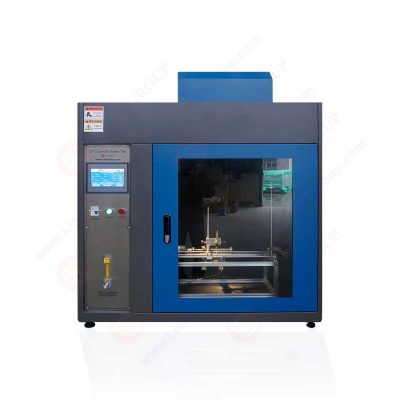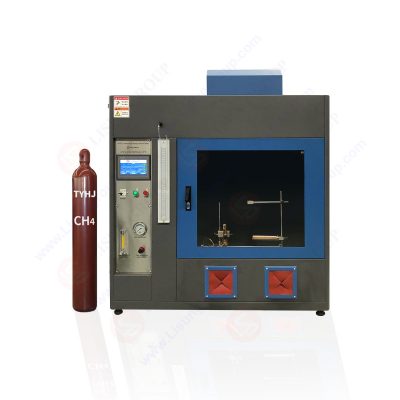Needle flame test is used to assess products that are prone to electrical or anyother fire hazards this article will look into different flame retardant test methods and how LISUN’s needle flame testers holds up in the market.
LISUN ZY-3 is a needle burner of a specific size (0.9mm) and gas (butane or propane). Burn test at 45° intervals at regular and directed intervals. ZY-3 is graded based on the ignition of the bedding layer and product and the maintained duration and length of combustion. Internal fire danger from small flames created by poor conditions.
Lighting, low-voltage electrical appliances, household appliances, machine tools, electronic instruments, information technology equipment, auxiliary parts, and other electrical and electronic equipment and its components research, production, and quality inspection departments, as well as insulation materials, engineering plastics, and other materials.
The needle flame testing instrument decides the relative leakage tracking index (CTI) and leakage tracking index (LTI) of fixed electrical insulating material when it is wet (PTI). The needle flame tester works for insulation materials, electrical appliances, and domestic equipment for humid situations. The resistance of the insulating structure to tracing is found.
Needle flame testing equipment ensures compliance with safety regulations. Many needle flame testing devices on the market today are made per outdated safety requirements. Because the quality of needle testers is uneven, and the main items may not satisfy the criteria of the standards, it is needed to calibrate the main items of the instrument to assure the accuracy of the measurement data.
ZY-3 Needle flame testers should be designed and manufactured by the requirements of IEC 60695-11-5:2004, GB4706.1-2005, IEC60335-1, GB5169.5-2008, and other standards, simulating the small flame produced by the products under failure conditions, and feeding into the products or materials to conduct fire hazard and combustion performance tests.
LISUN ZY-3 holds up to UL94, ISO 1210, GB/T2408-2008/IEC60695-11-10:1999, GB/T 5169.16-2008/IEC 60695-11-10 :2003/ASTM D635, GB/T 8332-2008/ISO 9772-2001/ASTM D4986, ASTM D4804 /ISO 9773,GB/T 5169.17-2008/IEC 60695-11-20 :2003/ASTM D 5048 IEC 60695-11-3 and IEC 60695-11-4.

needle flame test
1. Angle Adjustment:The flame angle can be adjusted as follows: Loose the knurled bolt in front of the combustor’s seat, hold it in your hand and rotate it to the desired angle, then lock it.
2. The needle flame tester had a set of flame strength test devices. The method used is: first, the thermocouple wire suspended with a temperature measuring copper block is placed directly above the needle, and the flame ignited. Press the “temperature test” button. The timer starts at 100°C and stops at 700°C. (Test standard requirement: 23.5 Seconds ±1.0S)
3. Flame Operation: reset the counter. Ignite the flame which will start the timing too. The flame will turn off when it’s set and the combustion seat will go back. The holding time will start timing at the same time. Pause the machine when the sample flame is extinguished.
4. Flame Adjust: Put the cylinder key in the set position. Turn the black ignition switch to ON. Light the flame in the apparatus. (Standard the flame height (12mm±1).
5. Test Sample Mounting: Adjust the sample’s height on the fixture as per the standard.
6. Test Finish:Open the fan to exhaust smoke and heat. Turn of all valves and ignitions.
The flame retardant function of electrical and other products is assessed with a needle flame tester. The IEC 60959-11-5 needle flame test device simulates a situation for testing products efficiently.
The most commonflame retardant tests are:
VW-1 (Vertical-Wire) Flame Test (UL 83)
Identical to the “All Wires Flame Test,” however the flame is not reapplied after 15 seconds if the sample is still burning, but only when the flame has been extinguished. A failure occurs when the sample burns for more than 60 seconds after any application.
Horizontal Flame Test (UL 44, 83) for LISUN HVR-LS Horizontal Vertical Flame Tester
A mild flame test was performed in a specific cage on a horizontal sample. For 30 seconds, a Tirrill gas burner with a 1500F flame is applied to the sample. The flame must not spread more than 2″ left or right of the point of application and burning particles falling from the cable must not ignite cotton on the test chamber’s floor.

HVR-LS Horizontal Vertical Flame Tester
All Wires Flame Test (UL 83)
A vertical flame test in an enclosure with a 1500 F flame utilizing a Tirrill gas burner. On the sample, a paper flag is placed 10 inches above the point where the flame reaches the specimen. The flame is applied for 15 seconds, then removed for 15 seconds before being reapplied. There is a total of 5 flame uses. If more than 25% of the paper flag is burned away, blazing, or glowing particles ignite the cotton base of the enclosure, or the sample continues to burn for more than 60 seconds after the final application of flame, the sample is declared unsatisfactory.
Vertical-Tray Flame Test (IEEE 383)
A rigorous test is typically applied to jacketed cables lashed to an 8-foot-high vertical metal ladder type tray. A ribbon burner with a flame temperature of 1500F and a heat source of 70,000 BTUs per hour serves as the combustion source. The cooking time is 20 minutes. The cable must not propagate the flame to the top of the tray, which is 6 feet away from the point of application.
Vertical-Tray Flame Test (UL 83, UL 1277)
Based on the IEEE test, with minor changes such as a flame temperature of 1600 – 1750F.
Vertical-Tray Flame Test (210,000 BTU)
Similar to the 70,000 BTU per hour test, except the heat source is increased to 210,000 BTU per hour.
The flame retardant tests methods are vast and they all serve somewhat different purposes. This leads the needle flame tests to be a successful form of assessing products and materials for fire hazards.
Lisun Instruments Limited was found by LISUN GROUP in 2003. LISUN quality system has been strictly certified by ISO9001:2015. As a CIE Membership, LISUN products are designed based on CIE, IEC and other international or national standards. All products passed CE certificate and authenticated by the third party lab.
Our main products are Goniophotometer, Integrating Sphere, Spectroradiometer, Surge Generator, ESD Simulator Guns, EMI Receiver, EMC Test Equipment, Electrical Safety Tester, Environmental Chamber, Temperature Chamber, Climate Chamber, Thermal Chamber, Salt Spray Test, Dust Test Chamber, Waterproof Test, RoHS Test (EDXRF), Glow Wire Test and Needle Flame Test.
Please feel free to contact us if you need any support.
Tech Dep: Service@Lisungroup.com, Cell/WhatsApp:+8615317907381
Sales Dep: Sales@Lisungroup.com, Cell/WhatsApp:+8618117273997
Your email address will not be published. Required fields are marked *